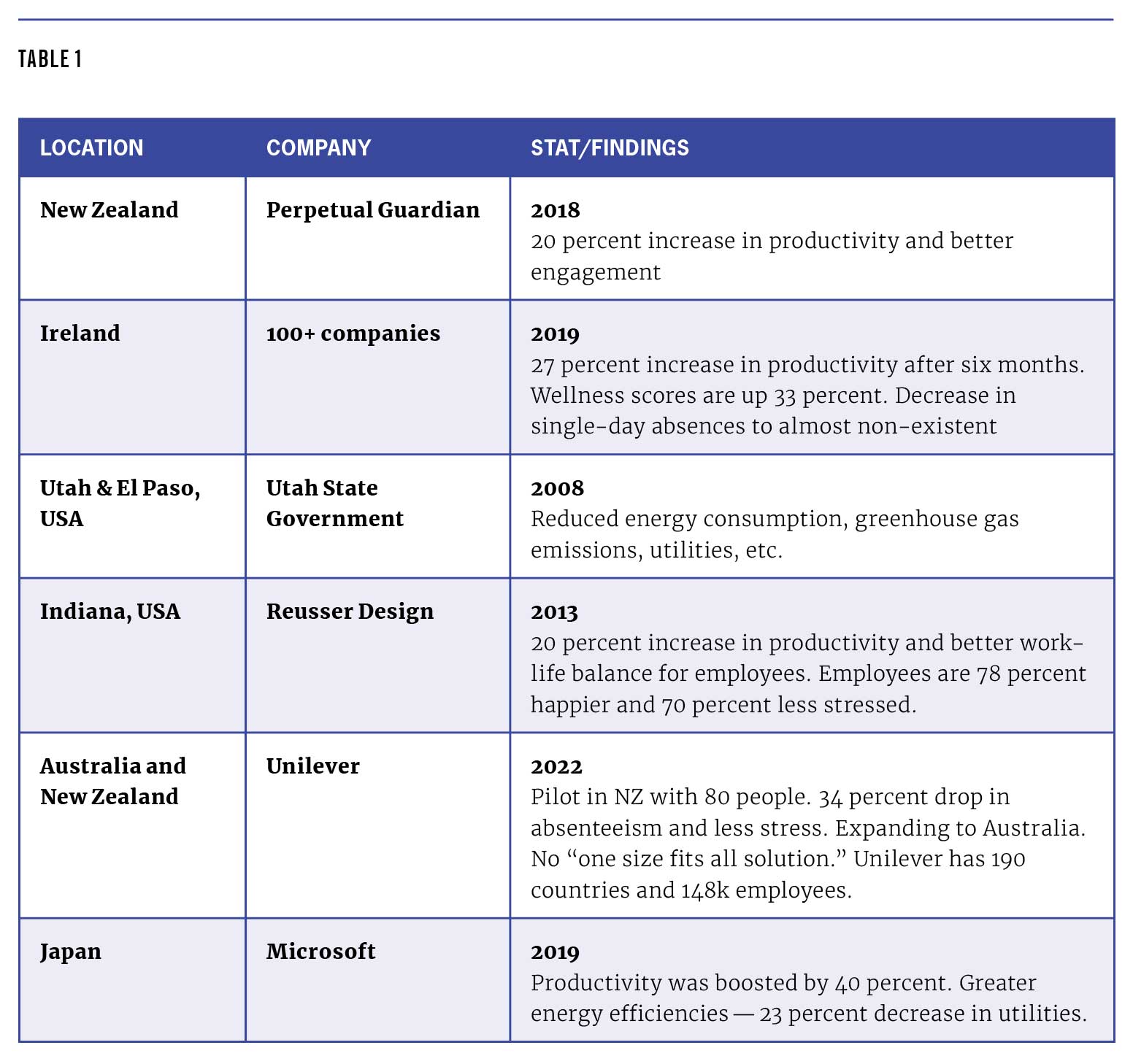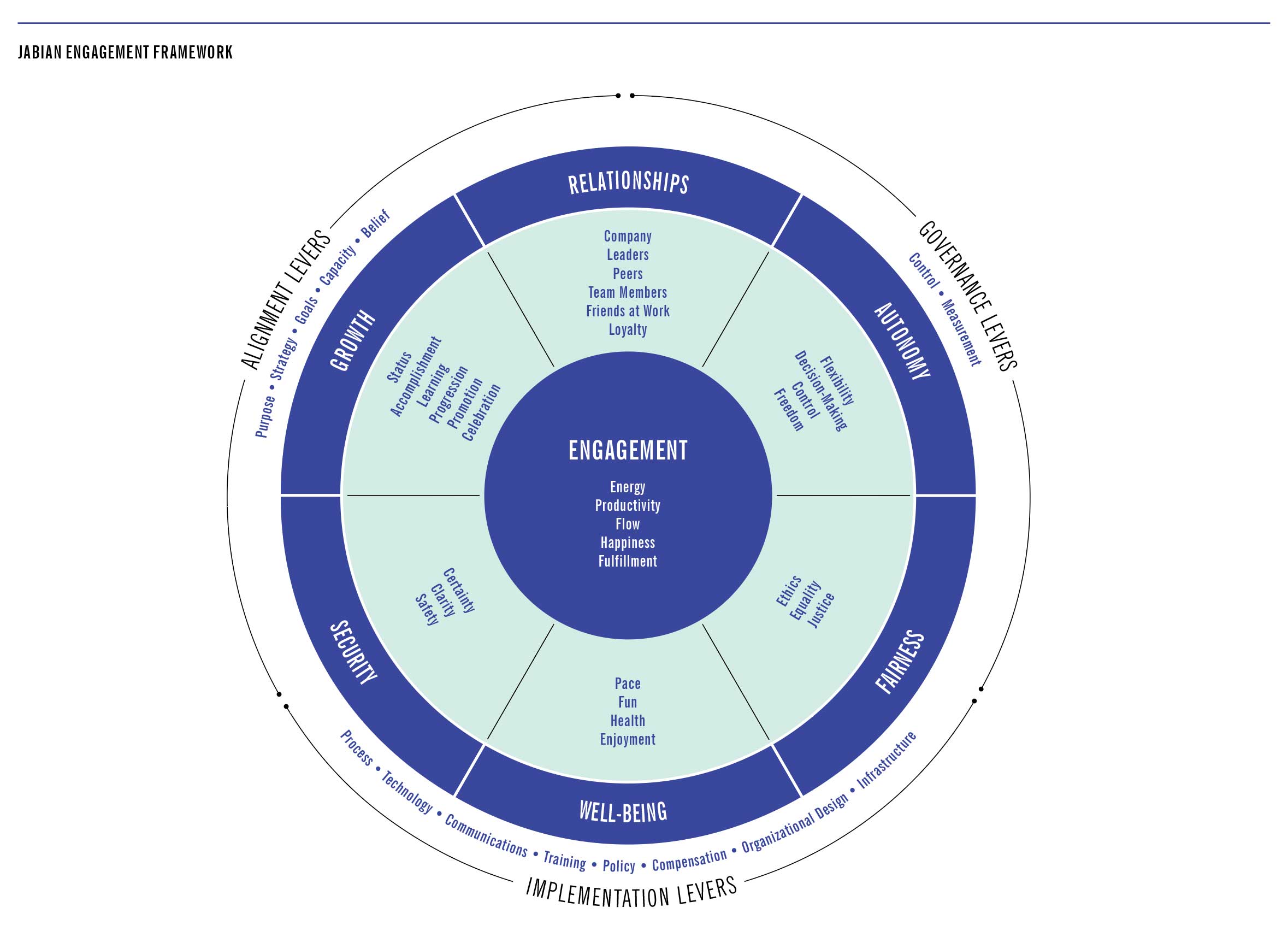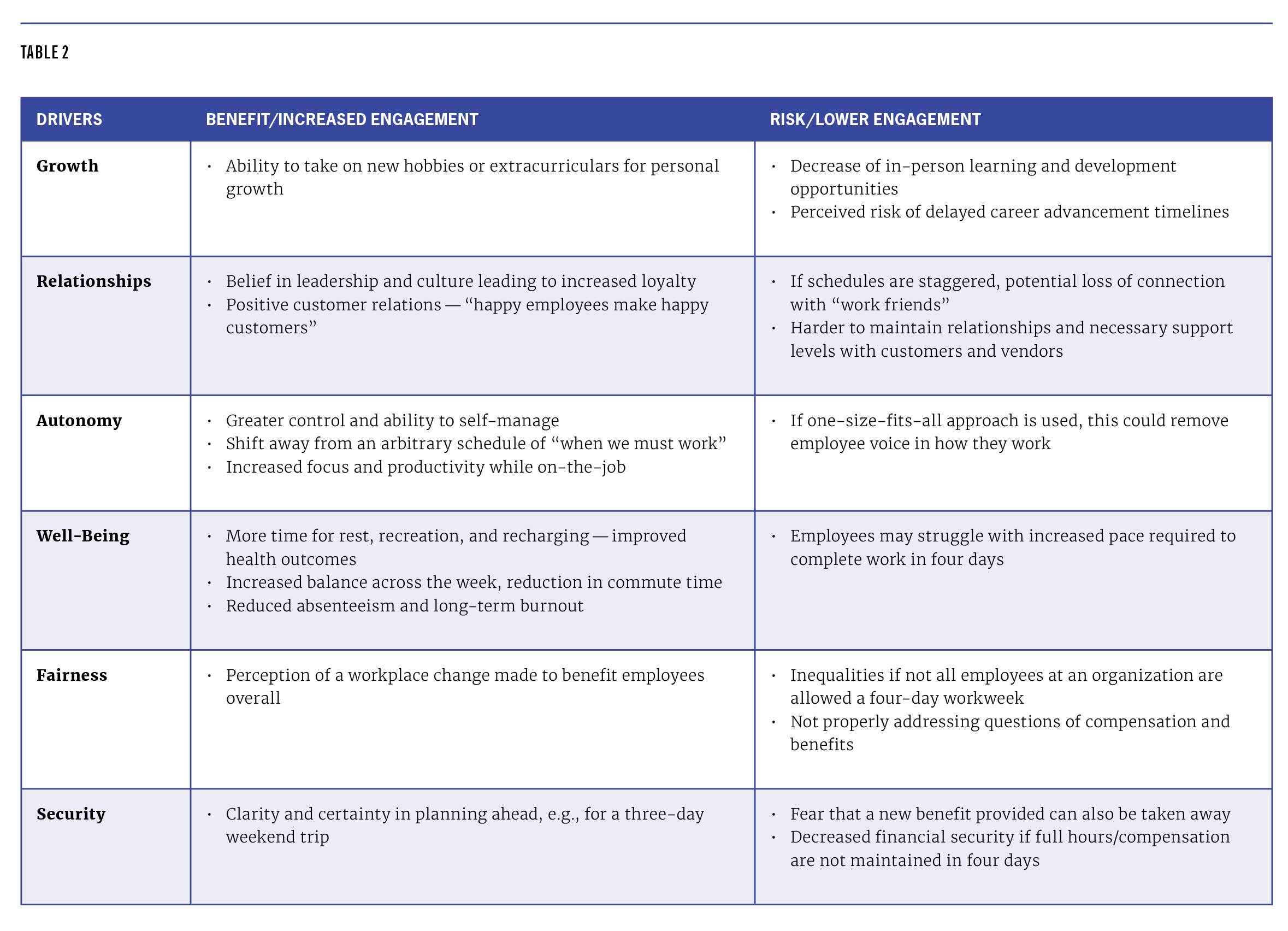The COVID-19 pandemic completely transformed the way employees and employers view work. With the widespread adoption of remote work and virtual collaboration, millions of workers have adjusted to the advantages of this new way of working, including a better work-life balance, increased schedule flexibility, and less time spent commuting to work. Three years later, 68 percent of Americans would still prefer to be fully remote, but most are in a hybrid role, encouraging companies to rethink their policies to accommodate flexible work arrangements that position them to maintain and garner top talent.1 As companies continue finding new and efficient solutions to operate while giving their employees desired autonomy, some have begun to question whether the traditional five-day workweek is truly an effective arrangement. Just over 100 years ago the standard five-day workweek we all know started during the Industrial Revolution when Henry Ford took his six-day workweek operation down to five days per week, with no changes in employee compensation.
Nearly a century later, most corporations still enforce this standard schedule, but the tide is beginning to turn. In the United Kingdom, 61 companies came together in 2022 to take part in the world’s most extensive four-day workweek pilot. The experiment used a 100-80-100 model: workers received 100 percent of the pay for working 80 percent of the time in exchange for delivering 100 percent of their usual output. The trial was a resounding success, with 92 percent of the participating companies committing to continue with the four-day workweek following the end of the program.2 Belgium, Japan, Scotland, and Spain have quickly followed suit, launching their four-day workweek pilots.
So, how do you know if a four-day workweek is right for your organization? You’ll want to consider factors — such as your industry, culture, and employee engagement impacts. To understand precisely how a four-day workweek could function, we will break down the findings of four-day workweek studies, explore impacts across six key drivers of employee engagement, and outline questions you can consider when determining whether a four-day workweek is right for your organization.
Findings of Four-Day Workweek Studies
Last year, one of the world’s largest four-day workweek pilots took place from June to December, with participating companies representing a variety of industries, including professional services, health care, construction, and manufacturing. The breadth of sectors involved shows that a new way of working is feasible in many workplace settings. However, it’s important to note that the size distribution of the companies represented in the study is primarily made up of smaller companies. While there were large companies, with employee counts in the thousands, most participating companies were small: “66 percent of participating companies had 25 or fewer employees, and only 22 percent of participating companies had more than 50.”3
The study gathered data by distributing surveys to all 2,900 participating employees at the start, midpoint, and end of the reduced work period. This enabled researchers to measure the employee experience throughout the study and gather insights into changes in employee engagement and well-being over time. The trial was a colossal success, with researchers finding that due to the shortened workweek, 39 percent of employees were less stressed, and 71 percent had reduced levels of burnout at the end of the trial.4 In addition, levels of anxiety, fatigue, and sleep issues decreased while mental and physical health improved.
Key Four-day Workweek Study Findings
- Employees Reporting Feeling Less Stressed 39%
- Employees Reporting Reduced Levels of Burnout 71%
- Reduced Attrition 57%
Of course, benefits related to employee well-being are important, but how did a decrease in working hours impact the bottom line? Additional company performance data were gathered, including revenue, number of employees, resignations, new hires, and sick/personal days taken. The study found positive effects across all of these key business metrics as well. Of the 23 companies that disclosed their financials, revenue remained consistent over the four-day workweek trial period and even rose slightly on average from start to finish. Furthermore, employee attrition fell significantly, dropping by 57 percent over the trial period, reducing the cost of staffing, onboarding, and overall operations.
While the recent media buzz caused by the extensive U.K. study has brought ideas of the four-day workweek to the forefront, this is not a new concept. Prior to the recent study conducted in the U.K., organizations have been experimenting with modifying the “traditional” work schedule for some time (see Table 1). A range of smaller studies over the past decade consistently saw that reducing working hours through a four-day workweek increased employee productivity, improved work-life balance and overall well-being, reduced stress levels and absenteeism, lowered operating costs such as utilities, and enhanced energy efficiency. These improvements to the employee experience often resulted in improvements in customer satisfaction, showing that as the workforce became more present and focused, they were better prepared to meet customer needs.

While the four-day workweek may not work for every company or every employee, the positive findings from this wide range of studies are significant and should begin to challenge how we think about work today.
What Could a Four-Day Workweek Mean for Employee Engagement?
To better understand the potential implications of moving to a four-day workweek, we thought it would be interesting to apply Jabian’s Engagement Framework5 to this proposal. As is often the case with complex problems, people are obviously at the heart of this question, and any successful organization wants to maintain productive, fulfilled, and engaged employees to the greatest extent possible. The Engagement Framework allows us to identify impacts across six key drivers of engagement to better understand where an organizational change may enhance or diminish employee engagement (see Table 2).


These employee engagement considerations make it clear that even a seemingly popular proposal like moving to a four-day workweek would carry quite a few risks to employee engagement in addition to the anticipated benefits. Thoughtful organizations pursuing this innovative work model would need a well-thought-out plan to deploy the model and communicate changes to employees to address their concerns and sources of disengagement while highlighting the benefits.
Other Considerations
While the four-day workweek arrangement may appear highly attractive to companies worldwide, there are a few important factors to consider before committing to this work model. It’s important to note that not all businesses can or should accommodate such flexibility. To successfully condense five days of work into four and maintain the same level of output, organizations must be diligent in removing inefficiencies — such as outdated processes, cumbersome systems, and unnecessary meetings. Following are five questions to consider before you determine whether this work arrangement is a viable option for your business.
Question 1:
Shortened or compressed workweek?

Employers must consider whether they will expect their staff to work a shortened 32-hour workweek or compress the 40-hour workweek into four days. Four-day workweeks using a 40-hour plan have increased in popularity, with 32 percent of U.S. employers offering this flexible schedule. Conversely, the 100-80-100 model from the U.K. study, with employers operating at 32 hours per week, has gained less traction, with less than 15 percent of employers offering this schedule. Responsible organizations pursuing this model will engage their employees in what they expect from a four-day workweek, considering factors such as fairness across employees, and clearly defining guidelines and parameters on how the program will function.
Question 2:
Can employees choose which four days they work?

Employers must determine what kind of four-day workweek they will implement. One option is closing the entire company’s operations for 72 continuous hours, creating a three-day weekend. The other option is work-based, also called a flex four-day workweek, where employees can choose which four days to work — this staggered schedule allows businesses to remain open five days — or more — a week. Consider whether schedules should vary for different teams and functions within the organization based on types of work and level of collaboration required, and whether implementing a four-day workweek would violate perceptions of fairness. Organizations exploring a four-day workweek program must strategically schedule employees to ensure core company functions are not compromised.
Question 3:
How would you implement a four-day workweek if your clients or customers do not?

Thoughtful organizations must evaluate their clients’ and customers’ needs before considering moving to a four-day workweek. Organizations in the client services industry might consider implementing a staggered schedule, with some employees working Monday through Thursday, and others working Tuesday through Friday to continue meeting any established customer service level agreements (SLAs). That way, there is an overlap in client contact, which will reduce the client experience impact. For hourly workers, organizations could consider increasing the number of daily working hours to eliminate any chance of lost wages, while staggering working days to continue meeting customer needs Establishing flexible policies to accommodate operational demands, peak business hours, and customer needs will be crucial to successfully transforming your business’s ways of working. Assess your internal and external client needs to determine if this approach is right for your organization.
Question 4:
How would this affect your company culture?

Consider the possible positive and negative impacts on your company culture. On the positive side, employees may feel more motivated and productive with an extra day off to rest and recharge, or an extra day to pursue learning or professional development opportunities. This may lead to increased job satisfaction and a better work-life balance, ultimately leading to higher retention rates and a more positive company culture. On the negative side, implementing a shortened 32-hour workweek may increase stress for employees trying to accomplish the same amount of work in a shorter week. Additionally, some employees may feel left out if they are not eligible for a four-day workweek, which could lead to resentment and a crack in camaraderie. Evaluate the potential impacts on your organization’s culture before switching to a four-day workweek.
Question 5:
How would you communicate this change?

Rolling out a four-day workweek is more than just sending a company-wide email. Developing a tactical change management approach is crucial to disseminating change throughout the organization. Consider the timing and the audience receiving the announcement, and additional support that people managers may require. Different groups of employees may have different concerns or questions regarding the change, so the communication should be tailored to address their specific needs. Developing the right messages is vital for successfully executing change; the organization should explain why the change is being implemented, what the employees’ new schedule will look like, and how the employees will benefit from this new way of working. Consider arranging training and support resources to guide employees through the transformation, as well as planning for ongoing communications to celebrate successes and reinforce the employee experience benefits.
Conclusion
The four-day workweek is not just a trend, but a potentially viable solution to the challenges of modern work-life balance. As we continue to navigate the changing landscape of work, it is time to seriously consider the benefits of a four-day workweek and explore how it can help us create a more sustainable and fulfilling future for us all. By reducing the number of workdays, employees may have more time to pursue their personal interests, spend time with their families, and recharge leading to increased productivity, job satisfaction, and employee retention. The study recently completed in the U.K. and examples from other companies transitioning to this model are just the tip of the iceberg. Soon employees worldwide may begin seeking new employment opportunities with greater flexible options. The four-day workweek is coming. Will your company be the frontrunner or be pushed to adapt to remain competitive?
Sources:
- https://www.zippia.com/advice/remote-work-statistics/
- https://www.nytimes.com/2023/02/22/business/four-day-workweek-study.html
- https://www.4dayweek.com/news-posts/4-day-week-uk-results
- https://www.4dayweek.com/news-posts/4-day-week-uk-results
- https://jabian.com/wp-content/uploads/2023/05/Ultimate-Field-Guide-to-Engagement.pdf
